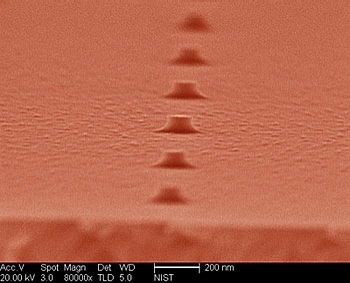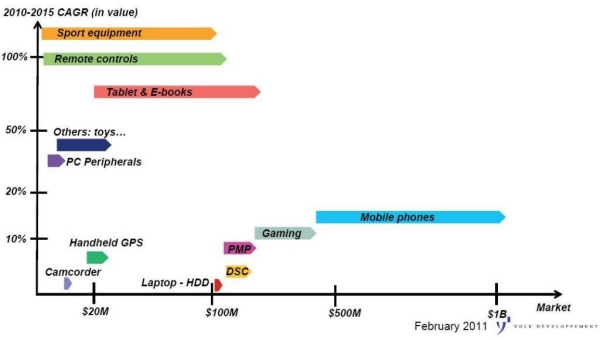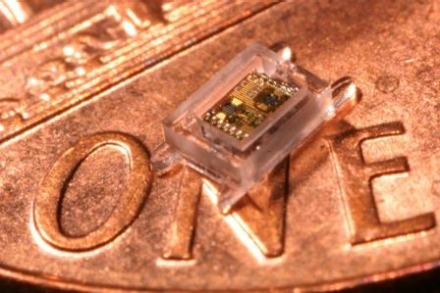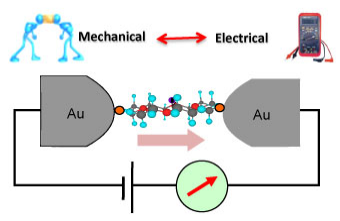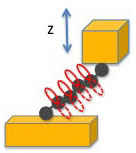February 22, 2011 – Vocus/PRWEB — GIA released a global report, "Micro Electromechanical Systems (MEMs) Devices: A Global Strategic Business Report," on the micro electromechanical system (MEMS) devices market, which is forecast to reach US$9.2 billion by 2015. An uptick in passenger car production, improving consumer demand, and dwindling stockpiles in the supply chain have revived MEMS shipments. Investments in new product development, innovation, and expansion of production capacity bode well for the future of the market.
The prolonged recession and credit crisis triggered price, volume, and revenue volatility in the MEMS industry. Consumer demand weakened for electronic devices/equipment, home appliances, telecommunications equipment, and automobiles. Demand for MEMS devices witnessed marked declines in the automotive and consumer products end-use sectors.
The automobile industry, a major high-volume end-user of MEMS technologies, was the worst affected by the recession. Although shielded to a degree by mandatory regulatory safety standards, especially in Europe and North America, automotive MEMS applications witnessed weakened business prospects as a result of the crushing effect of depressed automotive production. Investments in high-end dashboard electronics waned. Cheaper, affordable, less-equipped models additionally lowered demand for accelerometers for use in airbags, tire pressure monitoring systems (TPMS), and vehicle stability control.
Following automotive applications, the consumer MEMS sensor segment was worst hit. Specific segments such as mobile phones, PDAs, and business projectors fell hardest.
The recession also made a disproportionate impact on industrial production as a result of reduced manufacturing, commercial, and economic activity, thereby hurting industrial applications of MEMS for oil/gas exploration, instrumentation, and process industries, such as, food & beverage, chemicals, pharmaceuticals, plastics, rubber, textiles, among others.
In the telecommunication space, MEMS applications in optical networks also softened significantly. Network operators had to prune down investment outlays in 2008 and 2009 to hedge the financial weakness in the market as well as in the balance sheets. Cooling demand for fiber optic communication services, and broadband Internet services frustrated telecom carriers and as a result pushed fiber optic networking projects into an uncertain and unstable period. Several fiber optic broadband projects have been delayed as a result of network operators reining in capital investments. All of these factors impacted demand for optical telecom network equipment, and in the process the market for optical MEMS in telecom equipment.
Additionally, the complete meltdown of the real estate, housing and construction industry resulted in major disruptions of fiber to green field projects. Cancellation of new building projects resulted in reduced demand for fiber to the home (FTTH) technologies. Also impacted were fiber optics in brown field projects. All of these factors indirectly resulted in bringing down the level of orders for optical MEMS used in metro and long-haul optical telecommunications gear. Use of optical telecom MEMS in 1XN switches, Variable Optical Attenuators (VOAs), cross connects, Wavelength-Selective Switching Reconfigurable Optical Add/Drop Multiplexers (WSS ROADMs) and tunable filters, therefore withered, although temporarily.
With the recession now at its tail end, a sanguine future awaits the world MEMS market, with MEMS device manufacturers focusing on research and development to break into newer application areas. Microsensors and microactuators, which represent the hallmark of the electromechanical domain, are finding use in countless applications. Integrators will be reinforcing their MEMS component stocks to develop new state-of-the-art products, which deliver key features and functionality involving MEMS technology. Although commoditization has already set in with high-volume applications like consumer electronics and automotives, the technology continues to witness radical changes in other sectors like industrial, healthcare, and semiconductor, wherein MEMS+IC are influencing the traditional architecture of System on Chip (SoC).
MEMS technology to make medical diagnostic and monitoring technologies less invasive will garner special attention, especially so against a backdrop of a rapidly aging world population. The value proposition revolving around patient comfort, ease of drug delivery, and ensuing patient compliance will drive demand for MEMS in this space.
Inkjet printheads is the largest selling MEMS device. However, the inkjet printheads market is suffering the two-fold impact of the global recession and the ongoing transition from disposable to permanent printheads. As a result, unit shipments are forecast to decline through 2015. Beginning from 2011, MEMS displays will see encouraging growth due to demand for pico projectors and new MEMS flat-panel technologies for consumer electronics. ESC mandates will help spur the sales of accelerometers, gyroscopes, and high-pressure sensors, whereas TPMS mandates will propel MEMS pressure sensor sales by 2015. Europe and US account for a major share of the global Micro Electromechanical Systems (MEMs) Devices revenues, as stated by the new market research report. Global demand for MEMS in Medical/BioMedical End-Use is expected to increase at a robust pace during 2007 through 2015 period.
Major players in the marketplace include Analog Devices Inc., Apogee Technology Inc., Bosch Sensortec, Colibrys Ltd, Coventor Inc., Dalsa Semiconductor, Epson Toyocom, Hewlett-Packard, Invensense, IntelliSense Software Corporation, Kavlico Corporation, Kistler Instrument Corp., LioniX BV, MEMSCAP S.A., Memsic Inc., Micralyne Inc., NeoPhotonics Corporation, Panasonic Corp, Sensonor Technologies, Silicon Microstructures, Inc., STMicroelectronics, TowerJazz, Texas Instruments Inc, among others.
The research report titled “Micro Electromechanical Systems (MEMs) Devices: A Global Strategic Business Report” announced by Global Industry Analysts, Inc., provides a comprehensive review of market trends, issues, drivers, company profiles, mergers, acquisitions and other strategic industry activities. The report provides market estimates and projections (in US$) for major geographic markets including the United States, Canada, Japan, Europe (France, Germany, Italy, UK, Spain, Russia, Rest of Europe), Asia-Pacific, Latin America and Rest of World. End Use segments analyzed include Commercial/Industrial, Medical/BioMedical, Telecommunication, Computers, and Other Applications. Global MEMS devices market is also analyzed by product categories, such as, Accelerometers, Gyroscopes, Inkjet heads, Wafer Probes & Optical MEMS, Pressure Sensors, and Others. For more details, visit
http://www.strategyr.com/Micro_Electromechanical_Systems_MEMs_Devices_Market_Report.asp
Follow Small Times on Twitter.com by clicking www.twitter.com/smalltimes. Or join our Facebook group
